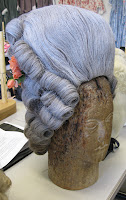Susan reporting:
More from Accessories: Head to Toe, a symposium hosted by Colonial Williamsburg, March 12-16, 2011.
No other accessory is so completely associated with the 18th c. than a wig, and preferably one dusty with powder. Dr. Anne Bissonnette, assistant professor in material culture & curatorship, & curator, clothing & textiles collection, University of Alberta, explored all-important hair in Off with Their Wigs! Traditions and Revolutions in Hairstyles, 1748-1804.
Beginning with a survey of famous wig-wearers (the modern fashion for wigs began with Louis XIII of France, compensating for this own flagging locks in 1632), Dr. Bissonnette described how wig-wearing evolved from a court style to one that became almost universal in 18th c. England. Wigs were not only another symbol of rank, affluence, and fashion, but they could represent gravity as well in the wigs worn by doctors, barristers, and judges. While most wigs were in the natural colors of white, grey, blond, and brunette, later in the century there are references to wigs of lavender and rose – though Dr.Bissonnette cautioned that that could also be interpreted as the wig's perfumed scent instead of the color.
But perhaps the most intriguing suggestion raised by Dr. Bissonnette concerned the influence of ancient Rome on 18th c. hair and wig styles. While most historians point to the cropped styles of the French Revolution as the beginning of classical styles, Dr. Bissonnette believes that the trend began much earlier in the century, spurred by the rediscovery of Pompeii in 1748, and there is an undeniable similarity between the tall stiffened curls of 18th c. wigs, upper left, and the hair shown on Roman portrait busts, lower left.
Robin Kipps, supervisor, Pasteur & Galt Apothecary, CW, explored a different aspect of 18th c. style with A Prescription for Health and Fashion. Doctors and other health experts of the time not only linked clothing as the cause of bad health (one example was swaddling infants, which could lead to convulsions), but also used clothing to dispense medicine, with aromatic herbs quilted into nightcaps to cure headaches and powdered Peruvian bark stitched into quilted waistcoats to be worn to fight ague (malaria.)
Specialized clothing also carried underlying messages about health. A woman's riding habit, upper right, was fashionable and flattering, but it also advertised to the world that the wearer practiced the healthy and often-prescribed regimen of riding.
Like modern doctors in scrubs, Georgian physicians wore distinctive clothing for their profession. While a surgeon making his rounds always wore his wig, a surgeon preparing to operate, lower right, wore a blue linen apron buttoned to his waistcoat and blue sleeves tied on to protect his arms. The traditional blue might have been simply because the color masked blood stains more readily than white – but can it be only an unsettling coincidence that 18th c. butchers are often depicted in caricatures wearing shirts of the same blue?
Upper left: Reproduction 18th c. wig, Colonial Williamsburg.
Lower left: Portrait of a woman of the Flavian period. Marble, 80s-90s A.D. Rome, Capitoline Museums.
Upper right: Reproduction lady's riding habit, c. 1770, Colonial Williamsburg
Bottom left: Reproduction surgeon's dress, c. 1770, Colonial Williamsburg




No comments:
Post a Comment